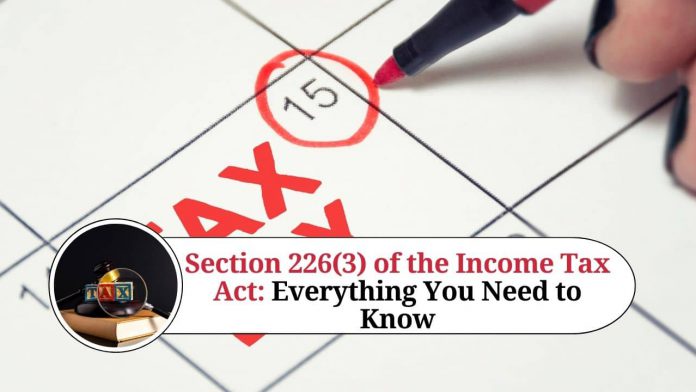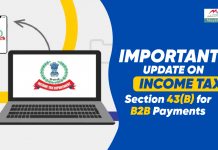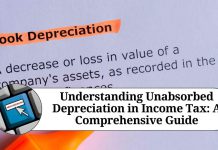Section 226(3) of the Income Tax Act: An Overview
The Income Tax Act of 1961 is a comprehensive legislation that lays down the various provisions for the assessment and collection of income tax in India. One of the important sections of this act is Section 226(3), which pertains to the deduction of tax at source and the obligation of the person making the payment to provide a certificate of tax deduction.
In this blog, we will take a closer look at Section 226(3) of the Income Tax Act and understand its various provisions.
What is Section 226(3)?
Section 226(3) of the Income Tax Act specifies that any person who is responsible for paying any income which is subject to deduction of tax at source (TDS) must furnish a certificate to the payee. This certificate should provide details of the tax deducted at source and other relevant information.
Who is Responsible for Furnishing the Certificate?
The person responsible for deducting tax at source and making the payment is also responsible for furnishing the certificate under Section 226(3). This person can be:
- A person making payment of salary
- A person making payment of interest or dividend
- A person making payment to a contractor or sub-contractor
- A person making payment to a professional or technical service provider
What Information should be Provided in the Certificate?
The certificate provided under Section 226(3) must contain the following information:
- The name and address of the person deducting tax at source
- The name and address of the person to whom the payment is made
- The amount paid
- The date of payment
- The rate at which tax has been deducted
- The amount of tax deducted
The certificate must be provided to the payee within the specified time limit.
Time Limit for Furnishing the Certificate
The certificate under Section 226(3) must be furnished within the following time limits:
- In the case of salary, the certificate must be provided annually on or before 31st May of the following financial year.
- In the case of interest or dividend, the certificate must be provided annually on or before 30th June of the following financial year.
- In the case of payment to a contractor or sub-contractor, the certificate must be provided annually on or before 30th June of the following financial year.
- In the case of payment to a professional or technical service provider, the certificate must be provided annually on or before 31st July of the following financial year.
Consequences of Non-Furnishing of Certificate
If the person responsible for deducting tax at source fails to furnish the certificate under Section 226(3), he shall be liable to pay a penalty of Rs. 100 for each day of default. The penalty amount, however, cannot exceed the amount of tax that was deductible.
Importance of Section 226(3)
Section 226(3) is an important provision of the Income Tax Act that serves various purposes. The provision ensures that the payee has information about the amount of tax that has been deducted at source. This information helps the payee to calculate his or her tax liability and file the tax return accordingly.
Moreover, the certificate of tax deduction provided under Section 226(3) serves as proof of tax payment for the payee. The payee can use this certificate to claim a credit for the tax deducted at source in his or her tax return. This prevents double taxation on the same income.
Section 226(3) also serves as a mechanism to ensure compliance with the provisions of the Income Tax Act. The provision puts the onus on the person making the payment to deduct tax at source and furnish the certificate of tax deduction. This ensures that the tax is deducted at source and paid to the government in a timely and efficient manner.
Penalty for Non-Furnishing of Certificate
As mentioned earlier, failure to furnish the certificate of tax deduction under Section 226(3) can attract penalties. The penalty for non-furnishing of certificate is Rs. 100 for each day of default. However, the penalty cannot exceed the amount of tax that was deductible. This penalty provision acts as a deterrent against non-compliance with the provisions of the Income Tax Act.
Legal Consequences of Non-Compliance with Section 226(3)
As discussed earlier, non-furnishing of the certificate of tax deduction under Section 226(3) can attract penalties. Apart from penalties, there are other legal consequences of non-compliance with Section 226(3). These consequences are:
Disallowance of Expense: If the person responsible for deducting tax at source fails to furnish the certificate of tax deduction, the expense incurred on that payment will not be allowed as a deduction in the computation of income of the person making the payment. This means that the person making the payment will not be able to claim the expense as a deduction in his or her tax return.
Non-Availability of Credit for Tax Deducted: If the certificate of tax deduction is not furnished, the payee will not be able to claim a credit for the tax deducted at source. This will result in double taxation on the same income.
Prosecution: Non-furnishing of the certificate of tax deduction can also result in prosecution under the Income Tax Act. Prosecution can be initiated if the tax amount involved is more than Rs. 25,000. The person responsible for deducting tax at source can be punished with imprisonment for a term ranging from 3 months to 7 years.
Conclusion
Section 226(3) of the Income Tax Act is an important provision that ensures transparency and accountability in the deduction of tax at source. It lays down the obligation of the person making the payment to furnish a certificate of tax deduction to the payee within the specified time limit. Failure to comply with the provisions of Section 226(3) can attract penalties and other consequences.
Read more useful content:
- section 145 of income tax act
- section 10e of income tax act
- section 9 of the income tax act
- section 94b of income tax act
- section 206aa of income tax act
Frequently Asked Questions (FAQs)
- What is Section 226(3) of the Income Tax Act?
Section 226(3) of the Income Tax Act requires the person responsible for deducting tax at source to furnish a certificate of tax deduction to the payee.
2. Who is required to furnish the certificate of tax deduction under Section 226(3)?
The person responsible for deducting tax at source is required to furnish the certificate of tax deduction under Section 226(3).
3. What is the time limit for furnishing the certificate of tax deduction under Section 226(3)?
The certificate of tax deduction must be furnished within 15 days from the due date of furnishing the statement of tax deducted at source.
4.What is the penalty for non-furnishing of the certificate of tax deduction under Section 226(3)?
The penalty for non-furnishing of certificate is Rs. 100 for each day of default. However, the penalty cannot exceed the amount of tax that was deductible.
5. Can the payee claim credit for tax deducted at source without the certificate of tax deduction?
No, the payee cannot claim credit for tax deducted at source without the certificate of tax deduction.
6. What is the consequence of non-furnishing of the certificate of tax deduction?
Non-furnishing of the certificate of tax deduction can result in penalties, disallowance of expense, non-availability of credit for tax deducted, and prosecution.
7. Is there a provision for rectification of errors in the certificate of tax deduction?
Yes, the person responsible for deducting tax at source can rectify errors in the certificate of tax deduction.
8. What is the consequence of furnishing a false certificate of tax deduction?
Furnishing a false certificate of tax deduction can result in prosecution under the Income Tax Act.
9. Can the certificate of tax deduction be furnished electronically?
Yes, the certificate of tax deduction can be furnished electronically in the format prescribed by the income tax department.
10. What is the purpose of Section 226(3) of the Income Tax Act?
The purpose of Section 226(3) is to ensure transparency and accountability in the deduction of tax at source and to provide the payee with information about the amount of tax deducted at source.




















